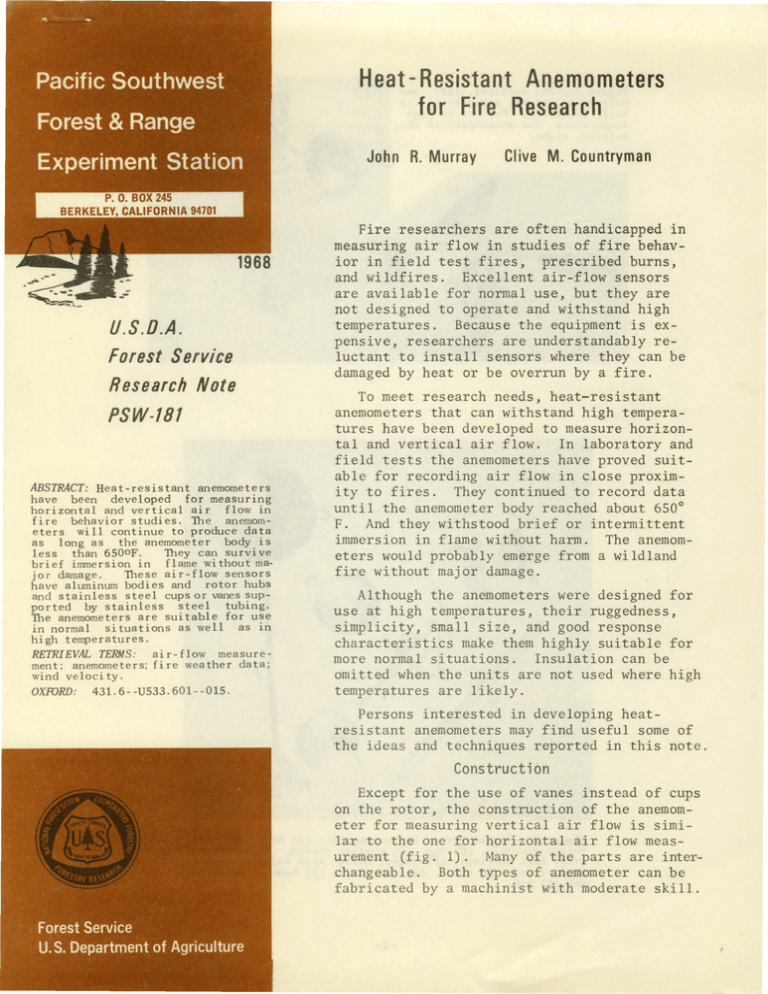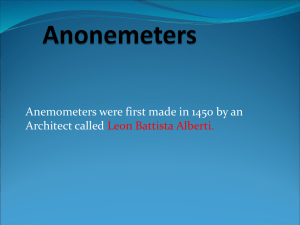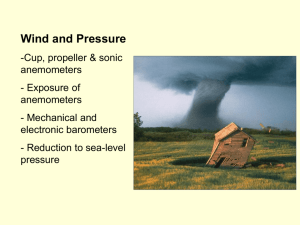- J- J ·.
advertisement

Heat- Resistant Anemometers for Fire Research Pacific Southwest Forest & Range John R. Murray Experiment Station Clive M. Countryman P. 0. BOX 245 BERKELEY, CALIFORNIA 94701 ---.......... J- J·. I I ' I U.S.O.A. Forest Service Research Note PSW-181 ABSTRACT: Heat-resistant anemometers have been developed for measuring horizontal and vertical air flow in fire behavior studies. The anemometers will continue to produce data as long as the anemometer body is less than 6500F. They can survive brief immersion in flame without majo r damage. These air-flow sensors have aluminum bodies and rotor hubs and stainless steel cups or vanes supported by stainless steel tubing. The anemometers are suitable for use in normal situations as well as 1n high temperatures. RETRIEVAL TERMS: air-flow measurement ; anemometers; fire weather data; wind velocity. OXFORD : 431.6--U533.601 - -015. Fire researchers are often handicapped in measuring air flow in studies of fire behavior in field test fires, prescribed burns, and wildfires. Excellent air-flow sensors are available for normal use, but they are not designed to operate and withstand high temperatures. Because the equipment is expensive, researchers are understandably reluctant to install sensors where they can be damaged by heat or be overrun by a fire. To meet research needs, heat-resistant anemometers that can withstand high temperatures have been developed to measure horizontal and vertical air flow. In laboratory and field tests the anemometers have proved suitable for recording air flow in close proximity to fires. They continued to record data until the anemometer body reached about 650° F. And they withstood brief or intermittent immersion in flame without harm. The anemometers would probably emerge from a wildland fire without major damage. Although the anemometers were designed for use at high temperatures, their ruggedness, simplicity, small size, and good response characteristics make them highly suitable for more normal situations. Insulation can be omitted when the units are not used where high temperatures are likely. Persons interested in developing heatresistant anemometers may find useful some of the ideas and techniques reported in this note. Construction Except for the use of vanes instead of cups on the rotor, the construction of the anemometer for measuring vertical air flow is similar to the one for horizontal air flow measurement (fig. 1). Many of the parts are interchangeable. Both types of anemometer can be fabricated by a machinist with moderate skill. Figure 1.- - The vertical , left, and horizontal , right, anemomet e rs are built similarly . For us e in high temperatur e , the anemomet e r is ins ul ated, right . Figure 2.--Compon ents of th e an emomet e r: ( A) body , ( B) reed swit ch as sembl y , ( C) c up, (D) wea th e r shi e ld, (E) stainless steel ball bearings, (F) magnet holder with magnets, ( G) support rod, (H) shaft, ( I) cup shaft, (J) body cover plate, and (K) hub. -2- Performance The body and rotor hub are turned from 1.25-inch aluminum bar stock. Cups for the horizontal anemometer are 2.1 inches in diameter and are spun from stainless steel. The vanes for the vertical flow unit are formed from stainless steel sheet. Stainless steel tubing 0.125 inch in diameter is used to support the cups and vanes. The weatherproofing cap on the anemometer body is also stainless steel. Because the cups and vanes are the most likely components to be damaged by fire, they were made removable for easy replacement. Vanes and cups were balanced by spot welding small pieces of stainless steel to the light members. Wind tunnel tests showed that the starting speed of the anemometers was between 1 and 2 ft./sec. The response of the horizontal anemometer to wind was linear to at least 90 ft./sec. (fig. 3). Response of the vertical anemometer with blades set at a 45° angle was nearly linear to speeds of about 40 ft./sec. (fig. 4). Above this speed the vanes tended to become distorted, and the response became nonlinear. This distortion could be lessened by using heavier material for the vanes or a smaller blade area, but this would sacrifice some anemometer sensitivity. The vertical anemometer responded to air flow at different angles close to the ideal cosine response (fig. 5). The response was only slightly different when the blades faced into the wind than when they faced away from it. The vertical anemometer did not respond to air flow at angles between 85° and 95° to the axis of the blades. Rotation of the cups and vanes is detected by means of permanent magnets and magnetic reed switches. The magnets are imbedded in an aluminum rotor attached to the anemometer shaft (fig. 2). Four magnets are used for the horizontal anemometer and two for the vertical unit. The magnets are glued in the rotor with epoxy cement, and then peened in to hold them in place in case of glue failure at high temperatures. Reed switches are used to determine direction of rotation and thus, whether air flow is up or down. They are imbedded in the anemometer body (fig. 2). The horizontal flow anemometer needs only one switch. Two reed switches are required in the vertical anemometer . Lead wires for the switches are butt-welded to the switch and insulated with fiberglass and silicon rubber sleeving. Two separate heat tests were performed on the anemometers. In the first test anemometers were installed 20 feet and 30 feet above the ground on a tower at the edge of a large pile of uprooted orange trees. The trees were then ignited and the pile allowed to burn out. During the peak flaming period of about 10 minutes, the anemometers at both levels were intermittently engulfed in flame. Thereafter they were nearly always in the hot gases arising from the fire. The anemometers continued to operate throughout the entire test--about 2 hours. A 3/8-inch layer of perlite with sodium silicate as a binder insulates the anemometers (fig. 3) . The anemometer is placed in a mold, and the insulating mixture is poured around it. Other insulating materials can be substituted for the perlite-sodium silicate mixture. A laboratory test was used to determine more precisely the capability of the anemometers to withstand heat. Thermocouples were attached to various parts of a vertical anemometer. Three large gas burners arranged in a triangle supplied heat. During the first part of the test the anemometer was -3- IOO r-----.-----.-----,-----,-----,------rl Figure 3.--The horizontal anemometer responded linearly to wind flow to at least 90 feet per second. 80 Y •- .00 8 + 0.005(X) 20 3 2 5 4 6 Millivol ts 40 ----~----~--~---,----.----.----.---~ Figure 4.--The vertical anemometer responded almost linearly to air flow at speeds of about 40 feet per second when blades were set at 40o angle. 10 3 2 4 5 7 6 Millivolts 8 100 --~---.-------.------,------,,------r------, ~,,, 80 60 b40 ~ ~ . ~ 20 ~ '' '' ', '' cos1ne re sponse actual respon se '' \ ' \ Figure 5. --Actual response of the vertical anemometer to air flow at different angles nearly approximated the cosine response. \ \ \ \ '\ \ \· ~ \ ~ o~--------------------1-\~•-------------------~ \ ~ c ~20 ~ ~ w \ \ \ \ \ \ '\ 60 '\ 80 '' '' '' ',,, '" 100o~----~30~-----6~0~----~9~0~----~,~20~----~,5~0~~~~0 A1r flow angle (degrees) -4- I I I I I I I I DOWN 22K 6.8K 6.8K UP COM. 22K 6.8K 6.8K I 00 47K .JL 100 .JL I I I I -12 2N697 .01 12K 9.1K IK Sensistor 9.1 K 12K 6 . 8K 6 .8K Pulse .----~height 200 ufd 6 .8K IOK adj. IOK 1500 2NI303 IN914 out up 200 ufd + out down or vertical \ +~Zero Center for vertical velocity + out down Recorder IN914 adjust value to fit recorder out for horizontal anemometer I + 1 out up or I horizontal •3Recorder -12 Figure 6- --Circuitry For recording anemometer output on a recording potentiometer. For the horizontal anemometer, use the section to the right of the dotted line; For the vertical anemometer, use both sections. The output network can be changed to Fit most recorders. Its capacitors can be adjusted to vary the response. -5- The tests suggested that the reed switch was the limiting factor in obtaining data from the anemometer at high temperatures. At about 650°F., the reed elements apparently became distorted and would not make contact. When cooled to 450° or 500°F. the switch would again begin operating. The updraft velocity indicated by the anemometer was nearly constant throughout the laboratory tests, indicating that the heating did not affect the calibration. supported about 12 inches above the flames, where the temperature varied between 500° and 600°F. The insulation surface temperature quickly reached 450° to 475°. Temperature of the anemometer body rose slowly and reached 410°F. after 22 minutes. The anemometer operated normally during this period, with no indication that the heat was affecting the calibration. After 22 minutes above the flames, the anemometer was lowered into the flames. The temperature in this region fluctuated considerably, but averaged about 1,500°F., with peaks to 1,800°F. After 4 minutes the body temperature reached 475°F. and the anemometer stopped. Bearings were left dry during the heat tests. Silicon oil can be used but is not essential. Ordinary lubricating oils cannot be used because they carbonize at high temperatures. Data Recording Although somewhat blackened, the exterior of the anemometer appeared normal. No distortion or damage was noted. Upon disassembling the anemometer, we found that dust particles that had gotten into the bearings during assembly had caused the rotor to stop. When cleaned and reassembled the anemometer rotor turned freely. The electrical pulses produced by the anemometers is best suited to a frequency meter recording system. Circuitry needed to record the output of the anemometers on a recording potentiometer is given in figure 6. An Esterline-Angus Speed Servo Recorder, Model S-601-SI was used in the anemometer tests. However, the type of recorder is not critical since the output network can be easily modified to fit most recorders. The anemometer was then subjected to further exposure in the flames. The blades continued to rotate freely as the body temperature rose to 900°F. The anemometer was removed from the flames at this ·point since the softening temperature of some of the construction material was approached. 1Trade names and commercial products or enter prises are mentioned solely for necessary in formation . No endorsement by the U. S . Depart ment of Agriculture is implied . The A u t h o r s - - - - - - - - - - - - - - -are studying problems in mass fires and fire behavior , with headquarters at the Station ' s Forest Fire Laboratory. Riverside, Calif '"OF.N R r,lURRJW. a 1954 forestry g raduate of ~rdue university, joined the Station ' s fire research staff in 1958 . CLIVE M. CXXJNTRYivlAN heads fire behavior studies . He earned B. S . degree in forestry at the Unive rsity of V:ashington (1940) , and joined the Forest Serv ice the followin~ year . -6-





